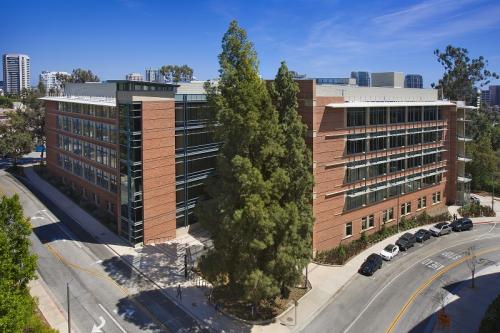
New, technologically advanced labs opened to expand research efforts at the UCLA Broad Stem Cell Research Center
New, technologically advanced laboratories will officially open today to expand stem cell research efforts – particularly for translating discoveries from bench to bedside – at the Eli and Edythe Broad Center of Regenerative Medicine and Stem Cell Research at UCLA.
The creation of the labs was funded through a $19.8-million grant awarded to UCLA two years ago by the California Institute for Regenerative Medicine (CIRM), the state agency that dispenses Prop. 71 monies to fund stem cell research.
The state-of-the-art Broad Stem Cell Research Center-California Institute for Regenerative Medicine Laboratory, located on the third floor of the new Terasaki Life Sciences Building on campus, will provide crucial facilities for approximately 88 scientists in about 21,000 square feet. Research conducted in the new space will range from basic stem cell investigations to preclinical translational science and, finally, clinical research.
“This new space will allow us to greatly expand and accelerate our stem cell research efforts in a quest to find new ways to treat a host of diseases for which we now have no effective therapies,” said Dr. Owen Witte, director of the Broad stem cell center and a Howard Hughes Medical Institute investigator. “Our new facilities are adjacent to biology, chemistry, engineering, medicine and clinical/translational research programs, which provides endless opportunity for the kind of innovative, interdisciplinary research that UCLA does so well.”
The new labs will be home to senior, mid-level and junior faculty dedicated to solving a wide range of stem cell research problems, including Dr. Donald Kohn, who in October 2009 received a $9.2-million disease team grant from CIRM to develop a blood stem cell transplant to cure sickle cell disease. Kohn, a professor of microbiology, immunology and molecular genetics and pediatrics and director of the Human Gene Medicine Program at UCLA, and his disease team will seek to treat sickle cell patients by transplanting them with their own bone marrow, using adult blood stem cells that are genetically corrected by adding a hemoglobin gene that blocks the sickling of the red blood cells.
Also located in the new lab space is Dr. Gay Crooks, who in June 2010 received a $1.35-million transplantation immunology grant from CIRM to develop a method to engineer and return into transplant patients new, healthy thymus tissue designed to protect against rejection. A professor of pathology and laboratory medicine, pediatrics and orthopedic surgery, Crooks’ work could result in immune tolerance of transplanted pluripotent stem cell derivatives, as well as the potential correction of auto-immune disorders.
“The research we’ll be doing in these labs has the potential to help alleviate human suffering,” Witte said.
The labs also will be home to technologically advanced equipment that can be used by stem cell and affiliated researchers to advance their scientific efforts. Such advanced technologies include DNA sequencing and bioinformatics equipment that will categorize, analyze and synthesize large scale data. It also will house a biophotonic laser-assisted cell surgery tool that can introduce molecules, bacteria and other small material into pluripotent and adult stem cells for disease modeling. Additionally, UCLA stem cell researchers will take cell separation and manipulation to the leading edge by establishing a bioengineering core to support the synthesis of new surfaces for growing human pluripotent stem cells and the development of new cell separation technologies, including the use of microfluidics.
The Terasaki Life Sciences Building and the new stem cell labs will officially open on October 25 with an 11 a.m. ceremony that includes Witte, Robert Klein, CIRM chairman, Alan Trounson, CIRM president, former senator Art Torres, CIRM vice chairman and Gene Block, UCLA Chancellor, among others.